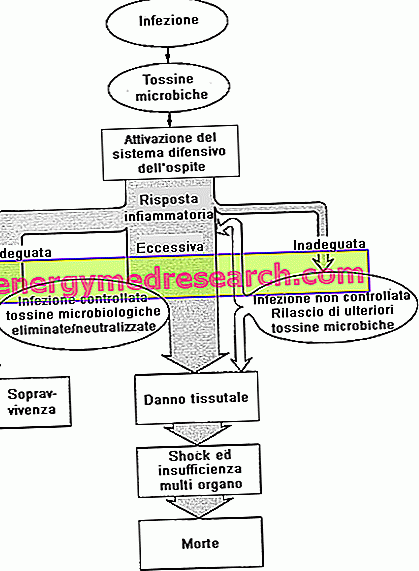Definition
Septic (or septicemic) shock is the most feared complication of sepsis; it is characterized by the drastic collapse of arterial pressure and the appearance of tachycardia and a cascade of events of increasing gravity.
Specifically, septic shock is a critical state of acute circulatory failure that results from a widespread infection in the blood. It is a threat to the health and life of the patient since septic shock, in the absence of medications or adequate interventions, gives poor prognosis (patient's death).
Causes
Septic shock being a complication of septicemia, it can easily be deduced that its origin lies in an infection of the blood, spread to the point of negatively (and often irreversibly) compromising the functionality of vital cells, tissues and organs.
Although bacteria are the pathogens most involved in triggering septic shock, even fungi and viruses can cause the same devastated damage. It should be pointed out, however, that pathogens in themselves do not create septicemic shock: the cause is rather sought in the release of their toxins which, once spread in the blood, reach organs and tissues.

Risk factors
From the study of numerous statistical analyzes it is clear that the patients most affected by septic shock are undoubtedly small children and the elderly, since their immune system, not perfectly formed or weakened, is not able to deal efficiently with infections. For the same reason, even patients suffering from AIDS, metabolic diseases (eg diabetes), lymphomas, pathologies of the genitourinary and intestinal systems and blood neoplasms (such as leukemia) are more exposed to the risk of infections in general, including those of the blood.
Again, some particular infections have been identified that may increase the risk of sepsis and septic shock. In the long list of the most dangerous pathologies we cannot forget: pneumonia, appendicitis, diverticulitis, meningitis, pancreatitis, necrotizing fasciitis and pyelonephritis.
Symptoms
To learn more: Septic Shock Symptoms
The degeneration of the pathogenic insult from septicemia to septic shock is not immediate: after the bacteria have reached the blood, the patient undergoes a series of catastrophic phenomena which, if not interrupted with a special life-saving therapy, proceed until inducing the death.
We therefore describe the progressive stages that lead to septic shock, highlighting the most frequent symptoms:
- Sepsis → clinical syndrome characterized by a series of secondary symptoms to infections that trigger the inflammatory response. It is manifested by heart rate disturbances, changes in respiratory rate, fever / low-grade fever / intermittent fever
- Severe sepsis → stage that anticipates septic shock proper. It manifests itself with heavy alterations affecting some primary organs such as the liver, kidneys, heart, brain (eg, liver failure, kidney failure)
- Septic shock → drastic collapse of arterial pressure and impossibility / difficulty to stabilize it through the administration of intravenous fluids. From the clinical point of view, in the patient affected by septic shock, a tangle of symptoms is observed: palpitations, restlessness, shortness of breath, high fever, chills, rash (possible), absent diuresis, severe hypotension.
ascertainment
To ascertain a septic shock status, the physician must assess the simultaneous presence of multiple unfavorable conditions, such as mainly:
- Systemic Inflammatory Response Syndrome (SIRS) or systemic immune response syndrome
- Established blood infection (sepsis)
- Insufficiency of one or more organs
- Refractory hypotension (extremely low arterial pressure, which does not respond to the classic intravenous treatment)
Diagnosis
We have seen that, by definition, septic shock is characterized by the simultaneous presence of the negative events listed above. But how to ascertain these conditions?
To simplify understanding, the most commonly used diagnostic tests for ascertaining septic shock and the questions the doctor must answer are given below.
Unfavorable condition | What to evaluate | Septic shock established if ... |
SIRS |
| → at least two of these conditions are observed in the patient |
SEPSIS |
| → an infection is detected in the patient |
INSUFFICIENCY OF ONE OR MORE BODIES |
| → at least one of the conditions described above is observed in the patient |
REFRACTORY HYPOTENSION |
| → hypotension persists even with adequate intravenous fluid treatment |
Treatment
Being a medical emergency, septic shock requires timely intervention.
Treatment for septicemic shock includes:
- Heavy antibiotic therapy: to be started only after having ascertained the infection through blood samples, wound swabs or organic fluid withdrawals.
Septic shock from unknown or unproven causes
In such circumstances, early administration of antibiotic drugs (eg gentamicin / tobramycin + third generation cephalosporin) can save the patient's life.
- Intravenous administration of fluids to normalize the pressure
- Administration of vasopressor drugs (eg noradrenaline)
- Mechanical ventilation
- Support of organ dysfunction
- Administration of corticosteroids
- Correction of any metabolic acidosis
- Treatment of the underlying disease
- Tracheal intubation or tracheotomy (when necessary)
The most appropriate therapy to try to reverse septic shock depends on several variants, that is on the pathology that led to it, on the severity of the symptoms and on the progression of the condition.
However, all patients with septic shock must be admitted to the intensive care unit and the physiological parameters (pressure, pH, function of the different organs, level of arterial gases, etc.) must be constantly monitored.
Prognosis
It is rather difficult to establish the prognosis of patients with septic shock. In general, life expectancies after an advanced septicemia and degenerated into septic shock are closely related to the moment in which one intervenes with antibiotics and emergency therapies. Clearly, the longer the medical examination is postponed, the higher the risk of a poor prognosis.
According to the " Robbins Basic Pathology " manual, the average mortality rate from septic shock is between 25 and 50%.



